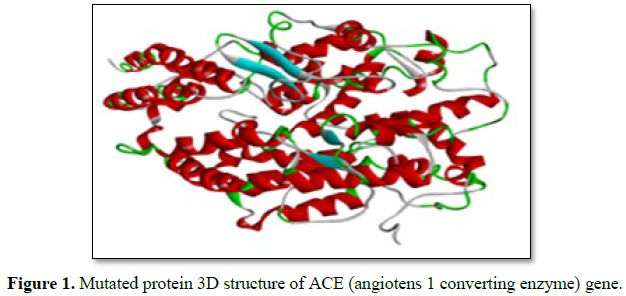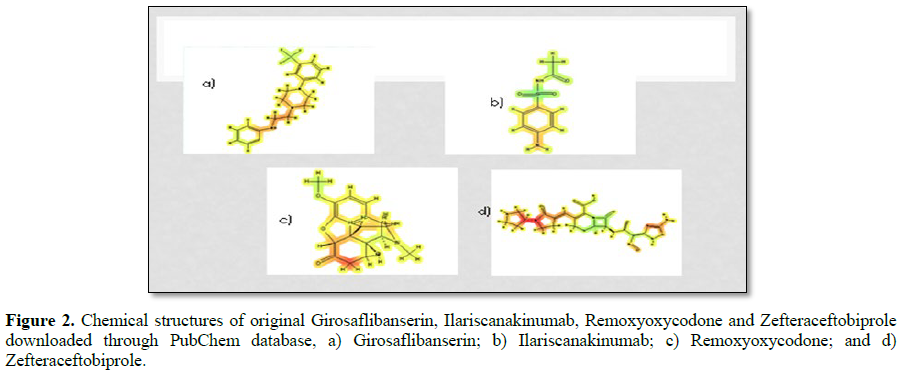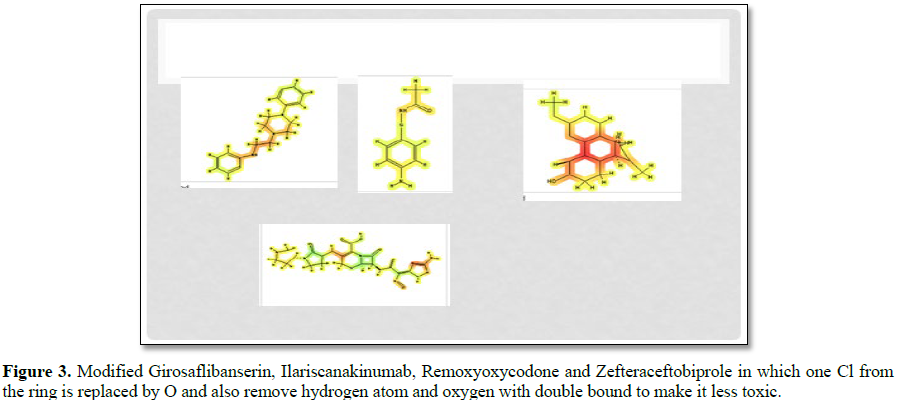616
Views & Citations10
Likes & Shares
Hypertension is the main source of heart disappointment and
cardiovascular comorbidities in created nations. Left ventricular
auxiliary/practical adjustments, for example, concentric renovating or
hypertrophy have been broadly considered in hypertensive heart ailments.
Besides, it is likewise all around perceived that diastolic capacity really
break down in hypertensive subjects preceding plain heart failure. In this
research work FDA rejected Girosaflibanserin, Ilariscanakinumab,
Remoxyoxycodone and Zefteraceftobiprole were selected. Drugs were changed on
the basis of side effects; modified drugs were docked with ACE (angiotens 1
changing over chemical) proteins and QSAR analysis was performed. The fewer
side effects and docking results of both modified Girosaflibanserin,
Ilariscanakinumab, Remoxyoxycodone and Zefteraceftobiprole suggest that both
the drugs can be used to cure mutations of genes in hypertensive heart disease
as all modified drugs have fewer side-effects and toxicity, as compared to
original drugs, all drugs have demonstrated greater interactions with the amino
acid residues lying in the pockets of mutated proteins that demonstrates their
stability and soundness.
Keywords: QSAR,
Girosaflibanserin, Ilariscanakinumab, Remoxyoxycodone, Remoxyoxycodone,
Zefteraceftobiprole, FDA, ACE
INTRODUCTION
Both the natural and
versatile insusceptible frameworks assume an imperative job in the advancement
and movement of heart disappointment (HF). The relationship among HF and
aggravation was first perceived in 1990 [1] who detailed hoisted levels of TNF
in patients with HF with a lessened discharge division (EF). An ongoing report
built up of those patients with hypertensive heart ailments showed more
elevated amounts of IL-18, a marker of inflammasome actuation [2]. Hypertensive
coronary illness was analyzed within the sight of any or blend of the accompanying
variations from the norm: left ventricular diastolic brokenness (e.g. adjusted
E:A proportion), left ventricular hypertrophy (ordered LV mass >51 g/m2),
left ventricular systolic brokenness and expanded left chamber, a surrogate of
disabled LV fling (left atrial distance across >3.8 cm in ladies and >4.2
cm in men) within the sight of hypertension. Left ventricular geometric
examples were shield as indicated by Ganau et al. [3]. Changes happening in
hypertensive coronary illness (HHD) and the job of non-intrusive heart imaging
arterial hypertension are the commonest reason for cardiovascular passing. It
might prompt hypertensive coronary illness (HHD) including heart disappointment
(HF), ischemic coronary illness (IHD) and left ventricular hypertrophy (LVH).
There is no agreement among new HTN rehearse rules as to target treatment of
circulatory strain (BP) among different subpopulations of patients. In any
case, most rules currently focus on a BP<150/90 for patients >80
MATERIALS AND METHODS
Data about the ACE (angiotens 1
changing over chemical) related with Hypertensive coronary illness was gotten
through writing [16]. Transformed protein ids of ACE (angiotens 1 changing over
chemical) proteins were downloaded through Research collaborator for basic
Bioinformatics (RCSB) protein database (PDB). RCSB PDB is for the most part a
database that involves X-beam crystallographic and atomic attractive The
Protein Data Bank (PDB) is the single overall document of tentatively decided
three-dimensional (3D) structures of proteins and nucleic acids it is
accessible at https://www.rcsb.org [17]. The
3D structures of proteins are shown in Figure
1. Compound structure of Girosaflibanserin, Ilariscanakinumab,
Remoxyoxycodone and Zefteraceftobiprole were gotten through PubChem database.
PubChem is an open database of the compound structures and natural test
outcomes, accessible at http://pubchem.ncbi.nlm.nih.gov
[18]. The substance structures of Girosaflibanserin, Ilariscanakinumab,
Remoxyoxycodone and Zefteraceftobiprole got through PubChem are shown in Figure 2.
Girosaflibanserin,
Ilariscanakinumab, Remoxyoxycodone and Zefteraceftobiprole were checked for
their danger esteems by the utilization of Protox server. Protox is a webserver
utilized for the forecast of oral poisonous quality estimations of little
medication mixes in the rodents. It is accessible at https://www.tox.charite.de/ [19]. Likelihood of reactions and genotoxicity risks of both the
medications were dissected through ACD Labs server, accessible at https://ilab.acdlabs.com/. The ACD Labs server is normally utilized for the in silico prediction of physicochemical, ADME and toxicity
properties of medication applicants. It enables researchers to comprehend QSAR
connections and to clarify the conduct of novel medication hopefuls. After the
estimation of symptoms proportions, all the Girosaflibanserin,
Ilariscanakinumab, Remoxyoxycodone and Zefteraceftobiprole were altered to
decrease the reactions and new mixes were composed in revelation studio
programming with lessened symptoms and poisonous quality. After change, the new
compound structures of the Girosaflibanserin, Ilariscanakinumab,
Remoxyoxycodone and Zefteraceftobiprole were checked for harmfulness and
symptoms from similar servers that were utilized previously, based on better
outcomes all the Girosaflibanserin, Ilariscanakinumab, Remoxyoxycodone and
Zefteraceftobiprole were docked with the downloaded 3D structure of transformed
proteins through the fix dock server [20]. Based on results, it is recommended
that all the altered Girosaflibanserin, Ilariscanakinumab, Remoxyoxycodone and
Zefteraceftobiprole can be utilized to treat transformations of hypertensive
heart maladies qualities. The likelihood of reactions of altered
Girosaflibanserin got through ACD Labs is shown in Table 1. Tables 2-4
exhibited that the adjusted Girosaflibanserin has less symptoms in a few organs
of the body when contrasted with unique Girosaflibanserin in this way, it is
less poisonous in nature, it will demonstrate better outcomes in the treatment
of hypertensive heart sicknesses, being non-lethal in nature.
RESULTS
It was seen that,
before alterations in the compound structures of Girosaflibanserin,
Ilariscanakinumab, Remoxyoxycodone and Zefteraceftobiprole, the harmfulness
estimation of Girosaflibanserin, Ilariscanakinumab, Remoxyoxycodone and
Zefteraceftobiprole, which was not dependable and viewed as perilous. What’s
more, all the mixes were laying in the high harmful classification of classes,
for example, class 2. The probability proportion of reactions of original Girosaflibanserin,
Ilariscanakinumab, Remoxyoxycodone and Zefteraceftobiprole were likewise
exceptionally high. The adjusted Girosaflibanserin, Ilariscanakinumab,
Remoxyoxycodone and Zefteraceftobiprole are shown in Figure 3. The
nearness of a Cl and H iota alongside the fragrant ring was a reason for
genotoxicity, in this way; the Cl and H particle was expelled and supplanted
with O molecule, which results in the decrease of harmfulness.
There are a few
classes of danger as indicated by the internationally blended arrangement of
grouping of naming of synthetic compounds fewer reactions in a few organs of
the body when contrasted with unique Girosaflibanserin, Ilariscanakinumab,
Remoxyoxycodone and Zefteraceftobiprole along these lines, it is non-dangerous
in nature, it will demonstrate better outcomes in the treatment of Hypertensive
coronary illness. Typically; medicate disclosure ventures based the examining
for lead structures. In any case; Virtual screening and sub-atomic docking
establishes remarkable alternatives to find hit mixes. Novel malady targets can
similarly be described and used together with sub-atomic docking devices
utilized in medication revelation programs [16]. The docked aftereffects of
changed Girosaflibanserin, Ilariscanakinumab, Remoxyoxycodone and
Zefteraceftobiprole with ACE (angiotens 1 changing over chemical) protein are
appeared in Figure 4.
The less symptoms and
docking consequences of all adjusted Girosaflibanserin, Ilariscanakinumab,
Remoxyoxycodone and Zefteraceftobiprole recommends that every one of the
medications can be utilized to fix transformations of ACE (angiotens 1 changing
over compound) in hypertensive coronary illness as every single altered
medication have less reactions and danger esteems. When contrasted with unique
medications, all medications showed more noteworthy cooperation with the amino
corrosive buildups lying in the pockets of transformed proteins that exhibit
their solidness and soundness. The more noteworthy the cooperation, the better
are the mixes as a medication applicant. Medication repurposing has a few
points of interest and the undertakings have been driven by a couple of basic
parts including; the entrance to growing proportions of exploratory data,
better perception of compound poly pharmacology and natural data mining. In silico procedures, either
receptor-based or ligand-based, have been adjusted to sedate repurposing
adventures. As of late repurposing approaches are used for huge scale testing
of medication activities on reaction targets [21].
DISCUSSION
Hypertensive coronary
illness treatment on a very basic level; centers around medication repurposing
frameworks for two reasons. As an issue of first significance, repurposing of
insisting and surrendered drugs for hypertensive coronary illness speaks to an
opportunity to rapidly advance to patients promising medicine medications by profiting
from existing data and experience. A similar system stays steady for
surrendered or “resigned” pharmaceuticals, whose improvement was suspended due
to non-safety related reasons [22]. In this examination venture, a similar
methodology is utilized to repurpose surrendered tranquilizes by making some
change in mixes to make the medication compound helpful in the treatment of
hypertensive coronary illness. In silico
procedures, both the receptor-based and ligand-based, have been associated with
sedate repurposing adventures. Keiser et al. [23] foreseen and endorsed 23
novel medicine target communications using two-dimensional compound similarity
approach. Ligand-based quantitative structure-action relationship models have
been used by Yang et al. to predict signs for 145 ailments using the responses
as highlighted [24].
CONCLUSION
The likelihood of
reactions of adjusted Girosaflibanserin, Ilariscanakinumab, Remoxyoxycodone and
Zefteraceftobiprole is not as much as unique Girosaflibanserin, Ilariscanakinumab,
Remoxyoxycodone and Zefteraceftobiprole. In docked buildings and QSAR
investigation, the two medications have exhibited more prominent associations
with the amino corrosive deposits lying in the pockets of changed proteins that
show their strength and soundness. The less symptoms and docking consequences
of all altered Girosaflibanserin, Ilariscanakinumab, Remoxyoxycodone and
Zefteraceftobiprole recommend that every one of the medications can be utilized
to fix changes of qualities in Hypertensive coronary illness as every single
adjusted medication have less reactions and lethality when contrasted with
unique medications. In future, this exploration work can be utilized as a piece
of clinical preliminaries to check its capability and social significance.
ACKNOWLEDGEMENT
Authors are grateful
to Bioinformatics International Research Club Abbottabad for providing a
platform to conduct research.
CONFLICT OF INTEREST
This research work is
unique and has not been submitted to any other journal. None of the authors
have any challenged conflicts of interest.
1. Africa
S (2017) HHS. Public Access 4: 1254-1268.
2. Drazner
MH (2011) The progression of hypertensive heart disease. Circulation 123:
327-334.
3. Drwal
MN, Banerjee P, Dunkel M, Wettig MR, Preissner R (2014) ProTox: A web server
for the in silico prediction of rodent oral toxicity. Nucleic Acids Res 42:
3-8.
4. Go
AS, Mozaffarian D, Roger VL, Benjamin EJ, Berry JD, et al. (2014) Executive
summary: Heart disease and stroke statistics - 2014 update: A report from the
American Heart Association. Circulation 129: 399-410.
5. Goetze
JP, Hilsted LM, Rehfeld JF, Alehagen U (2014) Plasma chromogranin A is a marker
of death in elderly patients presenting with symptoms of heart failure.
Endocrine Connections 3: 47-56.
6. Guerrero-Perilla
C, Bernal FA, Coy-Barrera ED (2015) Molecular docking study of naturally
occurring compounds as inhibitors of N-myristoyl transferase towards antifungal
agents discovery. Resumen Acoplamiento molecular de compuestos de origen
natural como 44: 162-178.
7. Janardhanan
R, Kramer CM (2011) Imaging in hypertensive heart disease. Expert Rev
Cardiovasc Ther 9: 199-209.
8. Keiser
MJ, Setola V, Irwin JJ, Laggner C, Abbas AI, et al. (2009) Predicting new
molecular targets for known drugs. Nature 462: 175-181.
9. Korkmaz
S, Duarte JM, Prlic A, Goksuluk D, Zararsiz G, et al. (2018) Investigation of
protein quaternary structure via stoichiometry and symmetry ınformation. PLoS
One 13: 1-20.
10. Lai
Y, Lo C, Wu Y, Hung C, Yeh H (2013) Cardiac remodeling, adaptations and
associated myocardial mechanics in hypertensive heart diseases. Zhonghua Minguo
Xin Zang Xue Hui Za Zhi 29: 64-70.
11. Lopez
AD, Mathers CD, Ezzati M, Jamison DT, Murray CJL (2006) Global and regional
burden of disease and risk factors 2001: Systematic analysis of population
health data. Lancet 367: 1747-1757.
12. Miura
K, Dyer AR, Greenland P, Daviglus ML, Hill M, et al. (2001) Pulse pressure
compared with other blood pressure indexes in the prediction of 25 year
cardiovascular and all-cause mortality rates. Hypertension 38: 232-237.
13. Natesh
R, Schwager SLU, Evans HR, Sturrock ED, Acharya KR (2004) Structural details on
the binding of antihypertensive drugs captopril and enalaprilat to human
testicular angiotensin I-converting enzyme. Biochemistry 43: 8718-8724.
14. Devereux
RB, Wachtell K, Gerdts E, Boman K, Nieminen MS, et al. (2004) Prognostic
significance of left ventricular mass change during treatment of hypertension.
JAMA 292: 2350-2356.
15. Rosenberg
SA, Aebersold P, Cornetta K, Kasid A, Morgan, et al. (1990) Gene transfer into
humans - Immunotherapy of patients with advanced melanoma, using
tumor-infiltrating lymphocytes modified by retroviral gene transduction. N Engl
J Med 323: 570-578.
16. Sani
Isa M, Bala GS, Oyati AI, Danbauchi SS (2010) Patterns of left ventricular
hypertrophy and geometry in newly diagnosed hypertensive adults in Northern
Nigerians. J Diabetes Endocrinol 1: 1-5.
17. Schiros
CG, Desai RV, Venkatesh BA, Gaddam KK, Agarwal S, et al. (2014) Left
ventricular torsion shear angle volume analysis in patients with hypertension:
A global approach for LV diastolic function. J Cardiovasc Magn Reson 16: 1-7.
18. Schneidman-Duhovny
D, Inbar Y, Nussinov R, Wolfson HJ (2005) PatchDock and SymmDock: Servers for
rigid and symmetric docking. Nucleic Acids Res 33: 363-367.
19. Tonne
JM, Holditch SJ, Oehler EA, Schreiber CA, Ikeda Y, et al. (2014) Cardiac BNP
gene delivery prolongs survival in aged spontaneously hypertensive rats with
overt hypertensive heart disease. Aging 6: 311-319.
20. Wang
Y, Xiao J, Suzek TO, Zhang J, Wang J, et al. (2009) PubChem: A public
information system for analyzing bioactivities of small molecules. Nucleic
Acids Res 37: 623-633.
21. Weir
SJ, DeGennaro LJ, Austin CP (2012) Repurposing approved and abandoned drugs for
the treatment and prevention of cancer through public-private partnership.
Cancer Res 72: 1055-1058.
22. Weltman
NY, Pol CJ, Zhang Y, Wang Y, Koder A, et al. (2015) Long-term physiological T3
supplementation in hypertensive heart disease in rats. Am J Physiol Heart Circ
Physiol 309: 1059-1065.
23. Xu J,
Liu Y, Xie Y, Zhao C, Wang H (2017) Bioinformatics analysis reveals microRNAs
regulating biological pathways in exercise-induced cardiac physiological
hypertrophy. BioMed Res Int.
24. Yang
L, Agarwal P (2011) Systematic drug repositioning based on clinical
side-effects. PLoS One 6.





